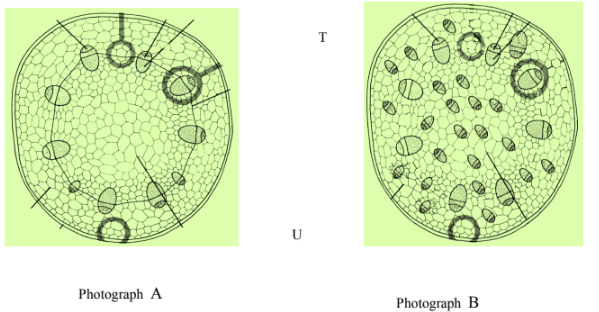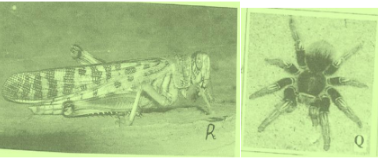INSTRUCTIONS TO CANDIDATES
- Answer all questions in the spaces provided in this question paper.
- You are supposed to spend the first 15 minutes of the 1 3⁄4 hours allowed for this paper reading the whole paper carefully before commencing your work.
- You are provided with visking tubing labeled J, a piece of thread and a solution labeled K.
Dip the visking tubing in distilled water to moisten it, open it, and then tie one end tightly with the thread provided.
Half-fill the visking tubing with solution K then tie the open end of the tubing tightly. Ensure solution K does not spill out of the tubing.
Immerse the visking tubing into distilled water in a beaker. Ensure that the visking tubing is completely immersed in the distilled water.
Leave the set-up for 20 minutes. Record your observations after 20 minutes.-
- Observations (1mk)
- Explain you observations in a (i) above (2mks)
- Remove the visking tubing carefully. Ensure the contents of the visking tubing do not mix with that of the beaker.Using the reagents provided, test for the food substance present in the visking tubing and the beaker.
- Visking tubing (3 mks)
FOOD TEST PROCEDURE OBSERVATIONS DEDUCTIONS Starch Reducing sugars - Beaker (3 mks)
FOOD TEST PROCEDURE OBSERVATIONS DEDUCTIONS Starch Reducing sugars
- Visking tubing (3 mks)
- Explain the observations and deductions in (b) above. (3mks)
-
- Below are photographs of cross sections through plant organs. Study them and answer the questions next.
- From Which plant organ were the sections obtained (1mk)
- Using observable features state the similarities and differences between organs from which the sections were obtained.
Similarities (2mks)
Differences
Organ from which section A was obtained Organ from which section B was obtained(3mks) - Which of the plants is likely to have a longer life cycle. Explain. (3mks)
- Name the type of cell labeled U (1mk)
- Name five parts that make up the plant organ illustrated by the photographs(5mks)
- Study the diagrams Q and R carefully and answer the following questions.
-
- Name the phylum to which specimens R and Q belong. (1mk)
- State three reasons for your answer in a (i) above. (3mks)
-
- Name the class to which each of R and Q belong (2mks)
- State two reasons for your answer in each of (b) (i) above (4mks)
- Other than (b) i) name other three classes of organisms (3mks)
-
CONFIDENTIAL
Each student should have;
- 4 test tubes and a test tube rack
- Iodine solution – supplied with dropper
- 10cm visking tubing labeled J
- Piece of string 20cm long
- 10cm3 solution of a mixture of soluble starch and glucose labeled K
N/B. 30g glucose mixed with 3g starch then add 100cm3 water and heat to boil then cool. - 500 ml beaker
- Adequate distilled water/ clean rain water
- Benedicts solution
- Means of heating/ Bunsen burner
- Measuring cylinder – 10 ml

MARKING SCHEME
-
-
- Visking tubing swells/ becomes turgid; (1X1 = 1mk)
- High concentration of water molecules in the beaker/ distilled water compared to the visking tubing/ solution K;Water molecules move by osmosis from beaker into visking tubing;
(1X2 = 2mks)
-
- VISKING TUBING
FOOD TEST PROCEDURE OBSERVATIONS DEDUCTIONS Starch Put food sample in test tube add iodine solution;
Dark blue/ Blue black/
Black;Starch present; Reducing sugars Put food sample in a test tube
add ( equal amount of Benedicts
solution heat / warm / heat in a
water bathFor blue, green,
yellow/orange/red;Reducing sugar
present;
4mks - BEAKER
NB: Procedure must be correct to preceede marking observation and conclusion / deductions (6 mks)FOOD TEST PROCEDURE OBSERVATIONS DEDUCTIONS Starch Put food sample in a test tube
add iodine solution ;Remain yellow brown; Starch absent; Reducing sugars Put food sample in a test tube
add (equal amount solution heat
/ warm/ heat in a water bath;Mixture turns from blue,
green, yellow/ orange/red;Reducing sugar
present;
- VISKING TUBING
- Starch molecules are large compared to glucose/molecules;Small sugar/ glucose molecules pass through the pores of visking tubing/ but not the large starch molecules;
OR
Visking tubing is semi-permeable/allows only small sugar molecules but not large starch molecules. (3mks)
Mark as a whole
-
-
- Young stems Accept Stem alone (1x1 = 1mk)
-
- Similarities (2mks)
- Both have vascular bundles with xylem and phloem
- Both have the cortex
- Both have the pith (1 x 2 = 2mks)
- Differences
- Organ from which section A was obtained Organ from which section B was obtained
- Vascular bundles are arranged in a Vascular bundles scatteredconcentric ring
- Pith is centrally placed Pith is scattered in the stem
- Cambium layer is present Cambium layer is absent
(1 x 3= 3mks)
- Similarities (2mks)
- Plant represented by diagram A has the cambium layer hence undergoes secondary thickening to form large structured plants which survives for a longer period of time. (1 x 3= 3mks)
- Parenchyma cell (1 x 1= 1mk)
-
- Epidermis
- Endodermis
- Cortex
- Vascular bundle
- Cambium rings
(1 x 5 = 5mks)
-
-
- Arthropoda; Reject Arthroponda;Anthropoda (1 x1 = 1mk)
-
- Presence of exoskeleton;
- Have segmented body;
- Jointed appendages (1 x 3 =3mks)
-
- R – Insecta Reject insect
Q – Arachnida Reject arachnid (1 x 2 =2mks) -
- R
- Three body regions;
- One pair of antennae
- One pair of compound eyes
- One pair of spiracles per segment Accept Three pairs of legs
(1 x 2 = 2mks)
- Q
- Body divided into two parts (Cephalothorax and abdomen);
Accept four pairs of walking legs (1 x 2 = 2mks)
- Body divided into two parts (Cephalothorax and abdomen);
- R
- R – Insecta Reject insect
-
- Crustacea
- Diplopoda
- Chilopoda
-
Download Biology Paper 3 Questions and Answers with Confidential - Form 3 Mid Term 2 Exams 2021.
Tap Here to Download for 50/-
Get on WhatsApp for 50/-
Why download?
- ✔ To read offline at any time.
- ✔ To Print at your convenience
- ✔ Share Easily with Friends / Students



